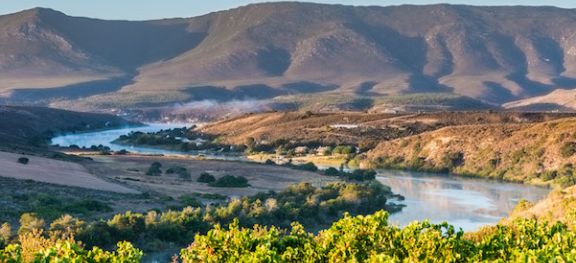Sijnn of Malgas

From 157.90 rand, HK$140, $19.75, €18.70, 189 Swedish krone, £18.95, CA$33.25, 25.06 Swiss francs, 3,369 Japanese yen, SG$45.50
One of the most exciting things about wine is that there are still clearly undiscovered wine regions with real potential. Until David and Rita Trafford visited it in 2000, this was true of Malgas, now an isolated one-producer ward of Swellendam in South Africa named after the local settlement.
It’s much further east than Elim or even Cape Agulhas, 15 km (9 miles) from the cooling influence of the Indian Ocean, from which winds reliably cool the vines almost every late morning. Temperatures rarely exceed 30 ºC (86 ºF). But what attracted the Traffords to this site was the combination of extremely poor, stony alluvial soils and, mainly, weathered shales (pictured) not unlike those of the Douro, sufficient and low annual rainfall of 350 mm (14 in) and the ocean influence. This means they can ripen grapes slowly but reliably on low-vigour, low-yield bushvines.
Their first vintage was 2007 and I was so impressed by their red blend that I made it a wine of the week in 2010. (Such is my great influence in the wine world that Floridans can pick up this wine today, reduced from more than $40 to under $20, at Wine Watch Boutique in Fort Lauderdale.)
Today Trafford, a member of the Cape Winemakers Guild, is one of South Africa’s most respected winemakers, with good reason. But he started out as an architect and it was a British wine merchant Simon Farr, founder of Bibendum Wines and now involved with Cru World Wine, who encouraged him to make particularly unmanipulated wine in his niche in the quiet Upper Blaauwklippen Valley in Stellenbosch. Along with environmental consultant Quentin Hurt, Farr is now a shareholder in Sijnn.
The name, which is apparently pronounced very like the French river ‘Seine’ (though the pronunciation of that name is arguably open to question), is a local Khoisan word. Although the first few vintages were made at De Trafford, the property now has its own simple winery, up a particularly long dirt road, apparently, but visitors are still welcome and their website lists several possibilities for accommodation and meals. Trafford keeps a close eye but Sijnn now has its own resident winemaker Charla Haasbroek, who has made wine at Tokara and Kanonkop. She is clearly not a city girl.
The wines have real poise and geographical signature about them. The principal production is Sijnn Red and Sijnn White, the former well able to mature for many a year in bottle. I was most impressed by Sijnn Red 2010 tasted earlier this week. It’s a fully integrated blend of 42% Syrah, 27% Touriga Nacional, 27% Mourvèdre, 10% Trincadeira and 3% Cabernet Sauvignon. I assume that the Portuguese grapes were planted to acknowledge the Douro-like soils. The Syrah is clearly the dominant ingredient and adds a little leathery quality but the Touriga is presumably responsible for the structure and the Mourvèdre perhaps for the spiciness. This is grown-up wine that retails for a ridiculously low rand equivalent of £10 a bottle in South Africa and can be found for the equivalent of just £12.56 in Hong Kong.
Wine-searcher.com lists stockists of various Sijnn wines and vintages not just in South Africa, the UK and US but also Ireland, Belgium, Germany, Holland, Sweden, Switzerland, Austria, Canada, Hong Kong, Singapore and Japan. Just click on the Find this wine link to find out more.
Sijnn White 2014 (82% Chenin Blanc, 11% Viognier, 7% Roussanne) is also looking good. Maybe not quite as convincing and distinctive as the Red 2010, it is still very much more complex and interesting than a commercial Chenin Blanc. Tasting it open (as opposed to blind in this analysis of South African white blends), I found an impressive combination of substance and refreshment, enlivened by both the honey flavours of Chenin Blanc and a little saltiness. The Viognier was not too obvious whereas I convinced myself I could find a little Roussanne herbiness.
Other Sijnn wines I have enjoyed include Sijnn Syrah 2013, Sijnn Syrah 2012, and an especially successful Sijnn Touriga Nacional 2012. For what it’s worth, I gave all these wines either 16.5 or 17 out of 20 – high scores for miserly me.
Also in the ground, or about to go into the ground, to add to the 16 ha (40 acres) of vines already planted, are Grenache Noir, Garnacha Peluda (Lladoner Pelut), Tempranillo, Tinta Cão, Grenache Blanc, Verdelho, Petit Manseng and my beloved Assyrtiko. Can’t wait!
Become a member to view this article and thousands more!
- 15,415 featured articles
- 274,315 wine reviews
- Maps from The World Atlas of Wine, 8th edition (RRP £50)
- The Oxford Companion to Wine, 5th edition (RRP £50)
- Members’ forum
- 15,415 featured articles
- 274,315 wine reviews
- Maps from The World Atlas of Wine, 8th edition (RRP £50)
- The Oxford Companion to Wine, 5th edition (RRP £50)
- Members’ forum
- Commercial use of our Tasting Notes
